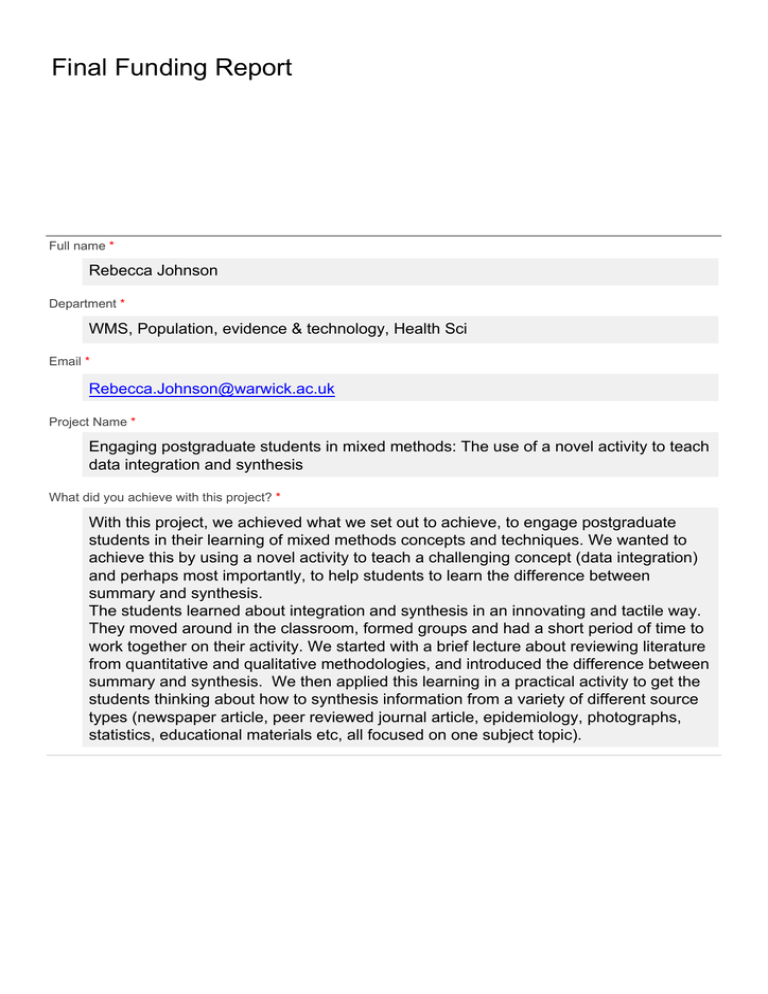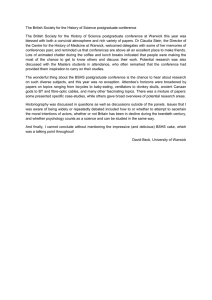Final Funding Report
advertisement

Final Funding Report Full name * Rebecca Johnson Department * WMS, Population, evidence & technology, Health Sci Email * Rebecca.Johnson@warwick.ac.uk Project Name * Engaging postgraduate students in mixed methods: The use of a novel activity to teach data integration and synthesis What did you achieve with this project? * With this project, we achieved what we set out to achieve, to engage postgraduate students in their learning of mixed methods concepts and techniques. We wanted to achieve this by using a novel activity to teach a challenging concept (data integration) and perhaps most importantly, to help students to learn the difference between summary and synthesis. The students learned about integration and synthesis in an innovating and tactile way. They moved around in the classroom, formed groups and had a short period of time to work together on their activity. We started with a brief lecture about reviewing literature from quantitative and qualitative methodologies, and introduced the difference between summary and synthesis. We then applied this learning in a practical activity to get the students thinking about how to synthesis information from a variety of different source types (newspaper article, peer reviewed journal article, epidemiology, photographs, statistics, educational materials etc, all focused on one subject topic). Final Funding Report What has been the single biggest impact of the project? * The biggest impact of the project has most likely been the enlivening of students. This session increased the levels of communication between students. Up to this point, students had communicated amongst themselves relatively little from an educational standpoint that is to say, they were not as forthcoming in other sessions as they were in this session. Two students who teach in their own professional work said that they would like to use a similar technique in their classrooms. They described the task as worthwhile and that it helped them understand the concept of synthesis on a more complete level. Challenge to teach because it was a new thing but when it came together at the end, that was a huge relief and rewarding for student and teacher alike. Postgraduate teaching and learning can sometimes fall into the trap of traditional lecturing and what results is somewhat passive learning. Students can miss out on opportunities to feel inspired and excited by their education because of this. By implementing this activity, we took a risk that it would fail. We feel that it has succeeded in the objectives we aimed for and we can continue to make it better each time we conduct the activity in future teaching sessions. What were the biggest problems you encountered during the project? * There were two types of problems we encountered. One was logistic, with the project leader on maternity leave, we had intermittent communication in the lead up to the session which caused some logistical challenges on the day. However, these were all minor. The activity would have benefited from a larger space and more time to arrange tables together and remove chairs and other things from the room to avoid distraction. The freedom to move around improved this activity. Second, during the activity some students continued to struggle with the conceptual differences between summary and synthesis during and after the activity. However, when all the groups came together to provide feedback, the final group to explain their subject synthesis really understood how to synthesise. As a result, the other groups could see the difference between summary and synthesis, and the session finished with a palpable increase in understanding of the concept as it applies to mixed methods. Finally, another logistic challenge was somewhat unavoidable. Because we had never run the session before, it was hard to know the best approach to lead the students out of their comfort zone during presentations/feedback. Most students went up to the front of the class to present for their group, and in doing so, tidied up their layout of activity cards. This had the effect of creating a more linear presentation of their subject story, when in reality the layouts each group had come up with were not necessarily linear (as we had encouraged in the instruction). Final Funding Report What student involvement was there on this project? * There was student involvement on the creation and implementation of the project. Marie Murphy, a PhD student at Warwick Medical School, assisted in all aspects of the project development and design, planning and execution. She was essential to the project and did the majority of the work in developing the activity cards and coordinating the filming of the activity session. How many students do you estimate were impacted by this project and in what way? * There were 17 students who participated in the module and in this specific session. Two students left the session stating they would like to repeat the session activity within their professional teaching roles elsewhere. The project had an impact on students in that they were challenged to learn in a different way. This challenge resulted in a deeper understanding of a key concept in mixed methods methodology for the students. We plan to increase the impact of the project by adapting it for use in other modules in the health sciences. Could you see your project being replicated or built on elsewhere in the University? * Yes. In fact, this project is an adaptation of the original activity developed by Nick Monk of IATL. I expressed an interest in adapting the project for use in the medical school and Nick kindly met with me to discuss the activity and we did a practical session at that meeting. From there I built on the idea to suit the teaching aims associated with the Mixed Methods for research in the Health Sciences module I was co-leading. Do you recognise in the outcomes of your project implications for the University and beyond? * Our activity supports innovative teaching practices and open space learning, a hallmark of Warwick University's innovative teaching image. It fosters critical thinking and enlivens students to participate and engage with concepts and with other students. Continuing to promote the use of this activity and others like it will be a legacy of this project (however small) within Warwick Medical School. More widely, students come from all over the world to take part in our modules and courses, and each time the activity from this project is used in a module, it will be a reflection of the value that Warwick holds in innovative teaching practice, and taken back with those students to share widely. Final Funding Report What evaluation of your project did you carry out and what were the results? * We have filmed aspects of the activity and created a short collection of clips from the day. Students were asked to evaluate the course teaching and the content, but this report has not been completed yet. Informal feedback from students on the day suggested that the activity was well received but that there was room for improvement. In addition to this, we filmed ourselves reflecting on the activity and how we would improve it for future iterations. Where will your project go from here? * We feel that the project overall has been a success. We plan to revise the activity in several ways for future use in the mixed methods module and also in other modules being run at the medical school. We will also write an editorial and submit it to the Reinvention Journal at Warwick University for further, more constructive reflection and promotion of this teaching activity. Here, we have taken an already excellent teaching activity adapted it for our teaching context and implemented it with the support of an interested and engaged student. We were able to achieve multiple learning outcomes and have demonstrated the flexibility and unbounded potential of innovative teaching practices.




